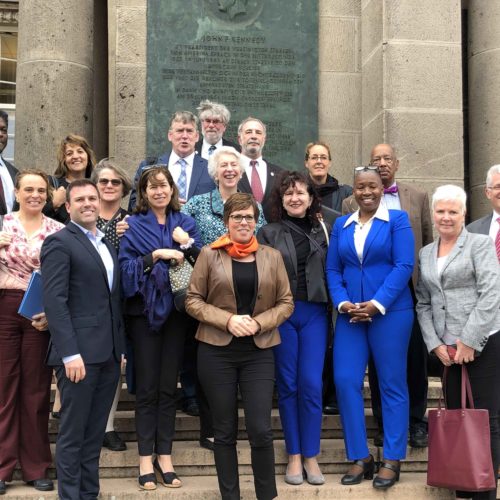Apprenticeships: A model for kickstarting a labor market recovery
This article appears in the 2021-22 edition of Perspectives.

Credit: Canva
The COVID-19 pandemic disrupted the global workforce, causing millions of people to leave their jobs. In recent months, as hiring has picked up, numerous sectors, including schools, health care, construction trades, and information technology, have faced worker shortages. Solving these workforce challenges will be essential for states, communities, and employers to regain their economic footing.
Much of the solution lies in strengthening the pipeline of trained workers, and one effective tool has been apprenticeship programs. These programs provide the public and private sectors with mechanisms for combining on-the-job training and classroom instruction to help the apprentice master the necessary skills to succeed. Employees benefit because apprenticeships lead to high-quality and lucrative careers, and states and communities benefit because apprenticeships are efficient paths to rebuilding and upskilling their workforce, engaging new business sectors, and helping economies recover.
Over the past year, numerous states throughout CSG’s Eastern Regional Conference (CSG East) have leveraged this work-based training tool to expand career opportunities for all workers and engage with new industries, employers, and priorities. The region has been a national leader in developing state task forces to improve apprenticeships, receiving substantial federal funding for apprenticeship development, and launching cutting-edge exploratory apprenticeship programs for new industries.
To support efforts in the eastern United States and beyond, CSG has worked to grow opportunities for programmatic and policy support around apprenticeships. In July, the U.S. Department of Labor (DOL) awarded CSG $4 million in funding to establish the Data and Best Practices Registered Apprenticeship Technical Assistance Center of Excellence. The center is dedicated to helping states and other apprenticeship stakeholders improve data-based systems and policy solutions in order to expand, strengthen, and improve the apprenticeship ecosystem. Further, with funding from CSG’s 21st Century Foundation, CSG has also established a civic sector apprenticeship consortium to develop and implement public sector apprenticeship programs in six states. The work of the consortium will culminate with an event at the 2021 CSG National Conference in Santa Fe, New Mexico, where states will hear from workforce experts and develop an action plan for the development of apprenticeships in their state. CSG has also published a number of resources and publications to support states in their apprenticeship efforts.
What are apprenticeships?
An apprenticeship is a high-quality career pathway where individuals can obtain paid work experience, classroom instruction, and a portable, nationally recognized credential, and employers can develop and prepare their future workforce.
Apprenticeships provide states the opportunity to develop a trained workforce pipeline to meet the needs of current employers and to develop the talent pool necessary to recruit new businesses. For workers, participation in apprenticeship programs provides valuable career skills while accruing little to no educational debt. This results in lower rates of unemployment and mitigates the long-term effects of economic recessions. In fact, 92 percent of apprentices retain employment in their field upon completion of the program, and the average apprentice will enter the workforce with a starting salary of $72,000. On average, individuals who complete these programs will earn over $300,000 more in lifetime earnings, according to the U.S. Department of Labor.
Apprenticeships traditionally have focused on trade occupations such as electricians, boilermakers, ironworkers, and plumbers. However, in recent years, the use of apprenticeships has expanded into many other industries, including health care, green energy, hospitality, information technology, cybersecurity, and public sector employment. With the support of the DOL, many states have taken steps to accelerate apprenticeship development across the country, including funding expanded career opportunities for all workers, especially those in underrepresented populations.
Apprenticeship programs in the eastern United States
Several states in the CSG East region are at the forefront of aggressive apprenticeship expansion. Here are some examples of their efforts:
1. Enacting legislation to improve workforce development
In 2018, the administration of New Jersey Governor Phil Murphy published a report calling for the state to increase the number of apprenticeship programs based on German, Austrian, and Swiss models; develop a holistic, people-first support system for professional development; and invest in innovative, sustainable jobs of the future. Consequently, the state enacted legislation that established a statewide task force to diversify apprenticeships and a five-year Apprentice Assistance and Support Services Pilot Program; encouraged high school students to engage in apprenticeship training early in their education; and allocated funding for a High Growth Industry Regional Apprenticeship Development Grant Pilot Program. The New Jersey Department of Labor and Workforce Development also distributed more than $3 million among 12 organizations to foster apprenticeship opportunities that will lead to the hiring of 1,264 new apprentices.
2. Utilizing American Rescue Plan Act (ARPA) funds to enhance workforce development and apprenticeship programming
In April, Connecticut Governor Ned Lamont proposed allocating $93.5 million of ARPA funds for job training programs in high-demand and high-growth sectors, including health care, manufacturing, information technology, and business and financial services. The initiative includes substantial funding for apprenticeship programs.
Vermont House Bill 439 (2021) allocates $2 million in ARPA funds to expand registered apprenticeship enrollment in current or new programs. The bill, which was signed into law by Governor Phil Scott in June, also transfers $100,000 to the Vermont Department of Labor for a pre-apprenticeship program in early childhood education provided by Vermont career and technical education centers.
3. Leveraging other federal funding to develop apprenticeship opportunities for historically underrepresented populations
Connecticut, Maine, Massachusetts, and Rhode Island have received State Apprenticeship Expansion, Equity and Innovation grants from the U.S. DOL — ranging from $3.9 million to $10 million — to expand programming and inclusive recruitment strategies to attract a diverse workforce. In a media release in June, U.S. Labor Secretary Marty Walsh said that increased funding opportunities for apprenticeships “[reflect] the Department of Labor’s renewed commitment to expanding Registered Apprenticeship to train U.S. workers and ensure that diversity and inclusion are core elements of our nation’s post-pandemic economic recovery.”
The DOL also invested in four Registered Apprenticeship Technical Assistance Centers of Excellence to support apprenticeship programs and their enrolled trainees. CSG is partnering on two of the centers, which allows CSG to provide additional supports and services directly to CSG East members. The centers also will support the work of the CSG Education and Workforce Committee by providing best practices; data; and access to resources on workforce development and other intersecting issues, such as education, equity and inclusion, and standards and practices in apprenticeship occupations.
4. Expanding apprenticeship opportunities into high-growth occupations, including the civic sector
The CSG Public Sector Apprenticeship Consortium works to equip and empower state policymakers — particularly legislators and executive cabinet staff in workforce development, education, and economic policy — to develop and implement public sector apprenticeships. The civic sector consortium is in its pilot year, with six states: California, Colorado, Idaho, Maine, Michigan, and Virginia. Maine has become a leader in developing innovative apprenticeship programs in the eastern United States. Maine has a two-year program for correctional officers housed within the Maine State Correctional Facilities and Maine Department of Labor. The Maine Apprenticeship Program is currently working to develop apprenticeship programming with three additional state agencies: Health and Human Services, Transportation, and Labor. “Within the next three years, we would like to establish apprenticeship programming as a cultural norm within Maine state government,” said Jessica Crosby, director of talent management in the Bureau of Human Resources. Through the civic sector initiative, CSG will support CSG East members in developing their own civic sector apprenticeship programs, identifying opportunities for growth, and mitigating the “silver tsunami” of soon-to-be-retired government employees.
Apprenticeships provide an excellent opportunity to encourage economic expansion. While CSG East has been a leader in apprenticeships nationally, there are more opportunities for growth. CSG is here to support members in the eastern United States and nationally by providing a policy forum, vehicle for sharing best practices, and structure for advocacy on issues affecting the region.




